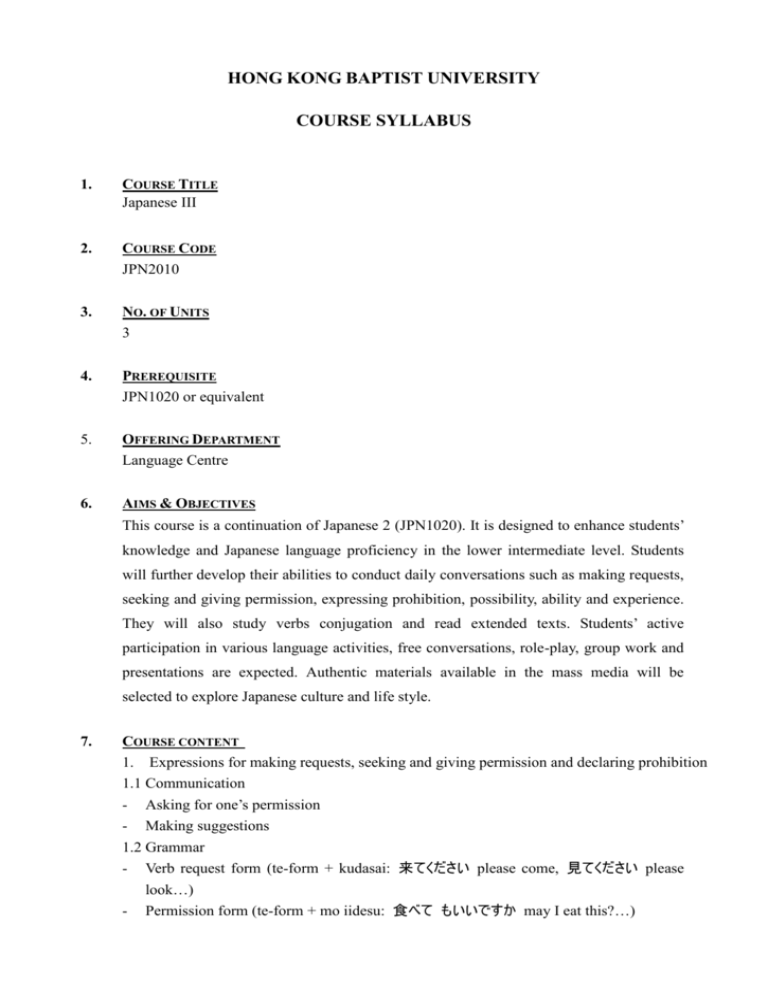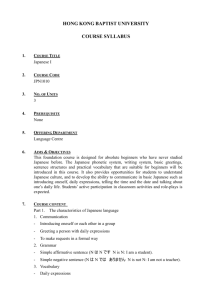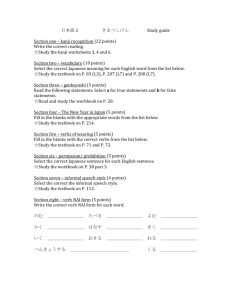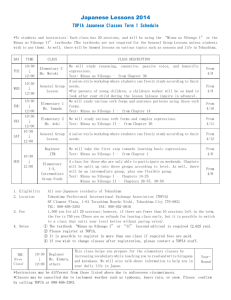HONG KONG BAPTIST UNIVERSITY
advertisement

HONG KONG BAPTIST UNIVERSITY COURSE SYLLABUS 1. COURSE TITLE Japanese III 2. COURSE CODE JPN2010 3. NO. OF UNITS 3 4. PREREQUISITE JPN1020 or equivalent 5. OFFERING DEPARTMENT Language Centre 6. AIMS & OBJECTIVES This course is a continuation of Japanese 2 (JPN1020). It is designed to enhance students’ knowledge and Japanese language proficiency in the lower intermediate level. Students will further develop their abilities to conduct daily conversations such as making requests, seeking and giving permission, expressing prohibition, possibility, ability and experience. They will also study verbs conjugation and read extended texts. Students’ active participation in various language activities, free conversations, role-play, group work and presentations are expected. Authentic materials available in the mass media will be selected to explore Japanese culture and life style. 7. COURSE CONTENT 1. Expressions for making requests, seeking and giving permission and declaring prohibition 1.1 Communication - Asking for one’s permission - Making suggestions 1.2 Grammar - Verb request form (te-form + kudasai: 来てください please come, 見てください please look…) - Permission form (te-form + mo iidesu: 食べて もいいですか may I eat this?…) - Prohibition form (te-form + wa ikemasen: 食べてはいけません you may not eat …) 1.3 Vocabulary - Various verbs (開けます open, 知ります know, 見せます show…) 1.4 Pronunciation - Proper accent of verb’s TE-form 2. Obligations, orders, polite prohibitions and permission 2.1 Communication - Talking and asking how to use something - Talking and asking about one’s obligations - Talking and asking about one’s actions in sequential order 2.2 Grammar - Describing 2 or more actions in sequential order (verb te-form, +verb / verv te-form + kara, verb) - Connecting adjectives (-i adj: 若くて、元気 young and active / -na adj: ハンサムで、親 切 handsome and kind…) Polite prohibition form (verb nai-form + naide kudasai: 吸わないでください please don’t smoke…) Obligation form (verb nai-form + nakereba narimasen: しなければなりません must do it…) Permission of verb-nai form (verb nai-form + nakutemo iidesu: しなくてもいいです no need to do something…) 2.3 Vocabulary - Adjectives for describing people (若い young, 頭がいい clever…) Parts of the body (体 body, 頭 head, 髪 hair, 顔 face, 目 eye(s)…) Describe physical condition and symptoms ( 熱 fever, 病 気 sickness, 薬 medication…) 2.4 Pronunciation Proper accent of verb’s NAI-form - 3. Possibility, ability and experience 3.1 Communication - Talking about one’s possibilities - Talking and asking about one’s hobbies - Talking and asking about one’s experiences 3.2 Grammar - Verb dictionary-form (寝る、歌う、予約する…) Expression of possibilities (verb dictionary + koto ga) Expression of experiences (verb-ta form + koto ga) 3.3 Vocabulary - Possibility verb (できる can, be able to, できない cannot,…) 3.4 Pronunciation - Proper accent of verb’s DICTIONARY form 8. COURSE INTENDED LEARNING OUTCOMES (CILOS) CILO By the end of the course, students should be able to: CILO 1 demonstrate a lower intermediate level of Japanese language proficiency through discussion and group work; CILO 2 describe people, living or working conditions and daily routines with the aid of a series of simple phrases and brief sentences; 9. CILO 3 apply learned vocabulary and sentence structures to create a series of simple phrases and sentences on familiar topics; CILO 4 demonstrate a thorough understanding of Japanese culture and lifestyle. TEACHING & LEARNING ACTIVITIES (TLAS) CILO No. CILO 1 TLAs Students will: CILO 2 read simple materials that introduce Japanese culture and society and discuss the content in groups; complete listening comprehension tasks and written exercises to express one’s own view; complete written exercises to reinforce the contents learned in class; write simple phrases and short sentences to describe one’s ambition after graduation; CILO 3 participate in group activities to make detailed descriptions of different objects and persons; practise role-play to communicate with others such as make requests, seek and give approval, explain or ask about past experience, as well as to express prohibition; describe in detail past events in sequence, hobbies and routine practices; CILO 4 learn more about Japanese culture and ways of thinking through DVD appreciation; 10. gain new insights into cultural differences between Japan and Hong Kong ASSESSMENT METHODS (AMS) Type of Assessment Weighting CILOs to be Description of Assessment Tasks addressed Vocabulary Test 5% 3 Vocabulary test will assess students’ ability to read and write vocabulary learned in Japanese 2 class. Mid-term Test 20% 1, 2, 3 Mid-term test will assess students’ reading and writing skills Listening Comprehension Test 5% 1 Listening comprehension test will evaluate students’ listening skills, as well as grammatical knowledge. Quiz (6) 5% 2, 3 Quizzes will measure students’ learning outcomes. Assignments (6) 10% 1, 2, 3 Assignments will give both the instructors and students valuable feedback to monitor students’ progress. Active participation in class 15% 1, 3, 4 Active participation in class is encouraged in order to gain a better understanding of the complexity of inter-cultural communications. Students’ interactions and communication skills will be assessed. Final examination 40% 1, 2, 3 The examination will assess students’ ability to write and read Japanese, as well as grammatical knowledge. 11. TEXTBOOKS / RECOMMENDED READINGS Minna-no Nihongo Elementary 2 (大家的日本語 初級 2) 大新書局. References: 1. 3A Corporation. (2001) Minna no Nihongo (elementary II). Taiwan: Dah-Hsin Publishing House. 2. 3A Corporation. (2002) Minna no Nihongo Workbook (elementary II). Taiwan: Dah-Hsin Publishing House. 3. 3A Corporation. (2001) Minna no Nihongo Videotape (elementary II). Taiwan: Dah-Hsin Publishing House. 4. Kobayashi Noriko, Tanba Junko, Takahashi Junko, Fujimoto Izumi, Miyake Kazuko. (1998), Mastering Japanese by Ear 99 Listening Work Sheets. Tokyo: Bonjin-sha. 5. Bunka Institute of Language. (1989) Bunka Shokyu Nihongo -Elementary Japanese Workbook of Bunka. Tokyo: Bunka Institute of Language. 6. Takahashi Miwako, Hirai Etsuko, Miwa Sachiko. (1994) kurasu katsudou shu 101-class activities 101- (elementary I). Japan: 3A Corporation. 7. Takahashi Miwako, Hirai Etsuko, Miwa Sachiko. (1996) kurasu katsudou shu 131-class activities 131 (elementary II). Japan: 3A Corporation. 8. Kuriyama Masuko and Ichimaru Kyouko. (1992) 50 Games for Drills in Learning Japanese. Japan: Mirion Ltd. 9. CAG Teaching Materials Development Group. (1993) 80 Communication Games for Japanese Language Teachers. Japan: The Japan Times. Syllabus prepared by: Ms. Takako Mochizuki & team members Date: 15 March 2010










